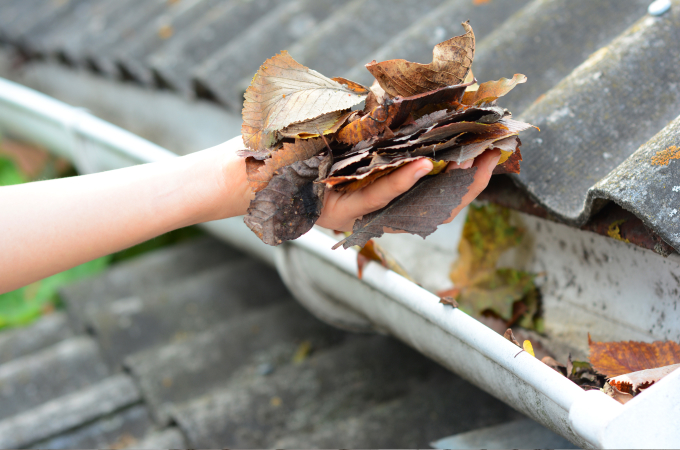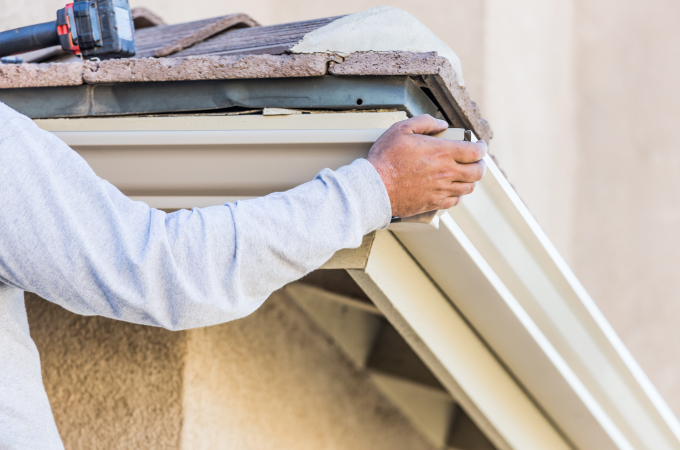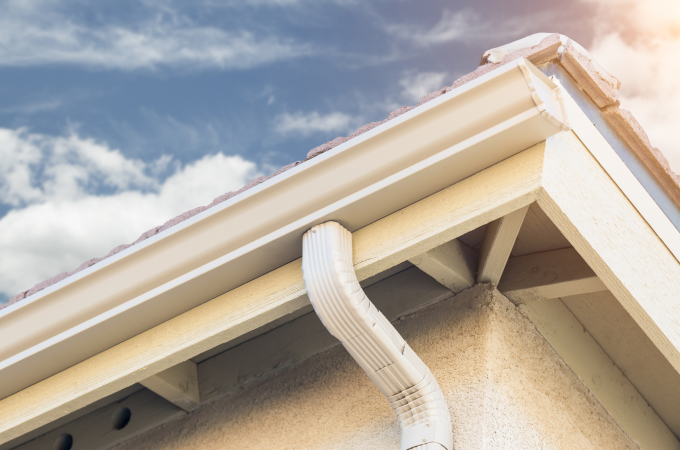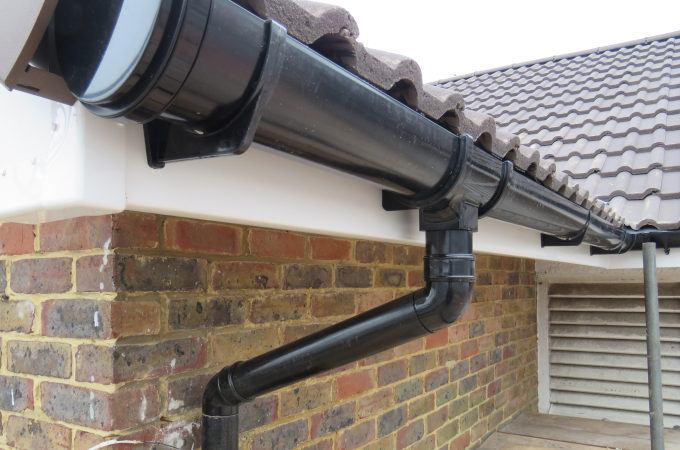Having an efficient gutter system installed on your home is critical in protecting your home from the havoc that water runoff can cause to a building’s exterior. . While gutters can keep rainwater moving in the right direction, clogged gutters can also lead to costly and damaging repairs needed to your home’s foundation, walkways, driveway, patio, deck, siding, roofing, and landscaping.
It’s important for homeowners to make cleaning rain gutters a regular component of home maintenance, but not everyone wants to invest in having a gutter cleaning service come over and get the job done. If you’re wondering how to clean clogged gutters on your own, the following is a simple 6-step process to getting your gutters back in clean, clear, and working order.
Telltale Signs That Your Gutters Are Clogged
- Sagging gutters
- Staining on your fascia boards and siding
- Water spilling over the gutter and particularly where the downspouts are located
- Erosion of the landscaping around the perimeter of the home
- Birds and other pests on your roof
The Damage Clogged Gutters Can Cause
During heavy rainfall, it is important to funnel water away from your home to avoid water damage to your roof, foundation, and landscaping. When there is a blockage in your gutters, both standing water and uncontrolled runoff can become costly problems.
Clogged gutters give water nowhere to go, meaning it can seep in through siding and roofing, causing basement floods and roof leaks. Standing water can also cause mold growth, mildew, damage to roof shingles and structure, and overall foundation damage.
Moreover, clean gutters help to guide water runoff from your roof away from your property during rainstorms. When your gutters are clogged, water moves wherever it wants, causing damage to mulch, flower beds, and lawn.
How to Unclog Clogged Gutters
- Put yourself at eye-level with the clogged gutters.
- Carefully Remove Gutter Guards if you have those installed.
- Remove debris.
- Take note of any damage.
- Test water flow.
- Flush the downspout.
Read on for a more in-depth explanation on each step.
Step 1: Put Yourself at Eye-Level with the Clogged Gutters
Attempting to clean clogged gutters without being able to see the entire system isn’t a safe approach and ultimately, just won’t work. It’s important that you find a secure way to put yourself at eye-level with the gutters in question.
A ladder is essential to getting gutters cleaned out effectively and efficiently. If you need a ladder to access the clogged rain gutters at eye-level, it’s important to also use the buddy system to guarantee a safe experience. For added safety, think about buying a ladder stabilizer. They also help prevent your ladder from leaving dents along your gutters and roof.
Have someone hold the ladder at the base until you’re lined up with the gutters and can clearly see how much debris needs to be removed. The ladder should always be attended to by a spotter until it’s no longer needed for cleaning.
Step 2: Carefully Remove Gutter Guards
Many gutter systems are outfitted with efficient gutter guards, but there’s no guarantee that debris won’t slip through in places. Before you can deal with clogged gutters, you need to carefully remove any gutter guards that are in your way. It may be possible to just remove a piece or two depending on the extent of the clogs. If there is just small debris and not too much build up you might be able to run a hose in the gutter to flush the gutters clean. It’s best to start at the furthest point away from the downspouts. Run the water into the gutter at a healthy flow and see if you can get the leaves and debris to flow towards the downspouts and wash through the system. If you aren’t able to flush everything through then you’ll need to remove more of the gutter guards to clean out the heavy debris.
Put on a pair of durable outdoor gloves to avoid any sharp edges while you unsnap and remove gutter guards. Some gutter guards are hinged so be sure to take note of how they are attached to the gutters before pulling to make sure not to damage the guards during cleaning.
Before you move on to cleaning out the gutters, it’s a good idea to rinse off gutter guards that may have debris clinging to the surface. Simply hose the guards down until leaves, twigs and other debris are no longer visible on panels.
Step 3: Remove Debris and Place it in a Bucket
If flushing the gutters with the hose didn’t work you’ll need to clean the gutters by hand. Grab a bucket and gently run your gloved hands through the gutters to remove any leaves, sticks, or other debris that are causing clogged rain gutters. It’s common for debris to be blown into gutters and for it to flow down with rainwater over time.
The process of cleaning out clogged gutters should be taken slowly to guarantee you’re catching all of the debris, but also being safe. Split the gutters up into small sections and move the ladder along the roofline at a pace that keeps you stable and comfortable, removing items as you go and placing everything in the bucket.
Step 4: Take Note of Damage Points
Chances are that as you’re carefully removing debris from clogged gutters, you’ll notice some points of wear and tear along the way. Damaged or missing gutter hangers are common as well. Knowing how to clean clogged gutters and keeping drainage systems in great working condition comes down to noticing the details like these.
Making it a point to keep gutter damage top of mind will ensure your system continues to protect your home efficiently and lasts for longer. As you clean the gutters, place small pieces of painter’s tape on any points of damage or corrosion so you can return after cleaning to handle necessary repairs. In general, a simple silicone sealant will do the trick.
Step 5: Test Water Flow
Once you’re confident you’ve cleared all of the debris from the gutters, it’s time to test water flow efficiency. Grab a garden hose and run swiftly moving water through the gutters to make sure you haven’t missed any areas of debris build-up.
This step ensures that gutters are clear and able to move water well around the home. It’s also a good final check to flush out any smaller debris items you couldn’t reach with your hands along the way.
If you notice water sitting stagnant at any point in the gutters, you’ll want to make minor adjustments as needed. High winds and storms can move gutters out of place and stop water from moving smoothly through the system. Repitch the gutters as necessary to get the proper pitch to allow the water to flow properly. A good rule of thumb is to pitch the gutters a quarter inch for every 10 linear ft. of gutter.
Step 6: Flush the Downspout
Finally, it’s important not to overlook gutter accessories that can clog just as easily such as the downspout. A simple way to make sure the downspout is just as clear and clean as the gutters is to use the garden hose to run water at high pressure from the top to bottom.
Flush the downspout from the top, where the elbow is connected to the outlet. Be sure to check that water is flowing out of the bottom. You may have to scoop out debris from the top and bottom of the downspout, but this should easily dislodge any loose debris. While you’re at it, be sure to check for debris that might have built up within downspout cleanout grates, wire strainers, or funnels and diverters.
If water from the garden hose alone isn’t moving debris in the right direction, it might be necessary to remove the downspout from the wall and take the elbows and downspouts apart and clean them each individually in smaller sections.
Everything You Need To Unclog Your Gutters
Gutter Supply is the industry-leading supplier for gutter systems, gutter guards, downspouts, rain chains, and many more gutter and roofing accessories.
Our online store features everything from half-round to k-style gutters.
Shop by material and see:
- aluminum gutters
- copper gutters
- vinyl gutters
- preweathered zinc gutters
- paint grip steel
- galvanized steel gutters, and more!
When you’re looking to equip your home with a gutter system that’s efficient and effective, we’re here to help.
Explore our online selection and if you have questions along the way, send us a message or call (888) 909-RAIN.
 Contractors
Contractors




